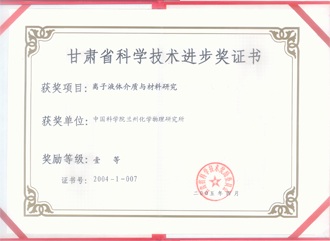Your Current Location is:
Ionic Liquids
|
File Name
|
Author
|
File Size
|
Download Path
|
邓友全,石峰 |
38.93 KB |
||
离子液体介质与材料研究是当前化学化工、功能材料的热点领域之一。1998年底以来,我们以发展离子液体清洁反应介质和软功能材料为研究内容,以实现新离 子液体的设计与合成,离子液体中无硫酸Beckmann重排反应、非光气异氰酸酯合成、二氧化碳吸收与活化、反应-升华分离一体化,微孔硅胶限制纳米尺度 离子液体材料的设计合成和应用及离子液体-电化学技术集成等为目标开展了一系列研究工作并取得良好进展。 邓友全,石峰,彭家建,等. 离子液体介质与材料研究. 甘肃省科技进步奖:一. 2004.
|
|||
邓友全,石峰 |
812.19 KB |
||
本发明涉及一种微孔材料装载金属络合物-离子液体催化剂。该催化剂通过钛酸酯和硅酸酯的溶胶凝胶过程将1,3-二烷基咪唑和烷基吡啶类离子液体及钯络合物 装载于微孔的钛硅复合氧化物中。该催化剂能够在80℃至200℃,氧气与一氧化碳压力比为0∶1至1∶2,总压力比在1.0至7.0MPa的条件下催化含 氮化合物羰化反应制备氨基甲酸酯和二取代脲。该催化剂的特点是催化活性高,离子液体和钯络合物装载或键合于载体之中,活性组分不易流失,可以重复使用,同 时降低了离子液体和钯络合物的用量,有效降低了催化剂的成本,具有良好的工业应用前景。 邓友全,石峰,彭家建,等. 微孔材料装载金属络合物-离子液体催化剂. Cn1389298. 2004. |
|||
李东梅 / 邓友全 |
246.74 KB |
||
Several acid-functional ionic liquids were physically confined into the silica gel through a sol–gel process and used as effective catalysts for deoximation reactions, which proceeded under ambient temperatures without addition of any co-catalysts or oxidizing and reducing agents. ★★★★☆ D. Li et al. / Tetrahedron Letters 45 (2004) 265–268. |
|||
刘从华 / 邓友全 |
164.54 KB |
||
The interactions between heavy metals (vanadium and nickel) and kaolin had been investigated by X-ray diffraction and MAT test. In the process of phase transformation of kaolin containing 1–5% vanadium, vanadium-mullite phase emerged surprisingly at 660–700 ◦C. The unit cell size of the mullite was found to increase with increment of vanadium content. As compared with hydro-kaolin, acid-modified kaolin(AMK) and caustic-modified kaolin (CMK) reacted with vanadium to form much more mullite; CMK could even be reacted with nickel to form a rather stable NiAl10O16 compound, and this compound protected zeolite in fluid catalytic cracking catalyst effectively. The catalyst containing AMK had greaterMAT activity retention than that of the contrastive catalyst with hydro-kaolin in the identical level of heavy metal contamination. ★★★☆☆ Keywords: Kaolin; Nickel; FCC catalyst; Vanadium; Mullite; Eutectic; Unit cell size ★★★☆☆ Conghua Liu, Youquan Deng, Yuanqing Pan, Shygin Zheng, Xionghou Gao. Applied Catalysis A: General 257 (2004) 145–150. |
|||
顾彦龙 / 邓友全 |
232.65 KB |
||
Reactions of propargylic alcohols with CO2 in a [BMIm][PhSO3]/CuCl catalytic system to produce the corresponding R-methylene cyclic carbonates were conducted with high yields. Mild reaction conditions, enhanced rates, improved yields, and recyclable ionic liquid catalyst systems are the remarkable features exhibited in this process. Furthermore, the use of large amounts of tertiary amines as well as nitrogen-containing organic solvent as employed in previously studies was avoided. ★★★★☆ Yanlong Gu, Feng Shi, and Youquan Deng. J. Org. Chem. 2004, 69, 391-394. |
|||
顾彦龙 / 邓友全 |
121.46 KB |
||
The solubilities of taurine (2-aminoethanesulfonic acid (H2NCH2CH2SO3H)) and sodium sulfate in a series of room temperature ionic liquids were examined, and a novel and greener separation method combined with chlorinated dialkylimidazolium ionic liquid as leaching reagent and organic solvent as precipitating reagent was developed. Using such process, selective separation of taurine from solid mixture containing large amount of sodium sulfate could be realized with 67–98.5% of single separation yield. The recycling of ionic liquid and organic solvent used in this separation process is possible. ★★★☆☆ Keywords: Ionic liquid; Leaching separation; Taurine; Solubility; Sodium sulfate ★★★☆☆ Y. Gu et al. / Separation and Purification Technology 35 (2004) 153–159. |
|||
邓友全 |
241.24 KB |
||
Under mild conditions and without any additional organic solvents, Beckmann rearrangement of ketoximes was performed in a novel task-specific ionic liquid consisting sulfonyl chloride. Especially for the conversion of cyclohexanone oxime to e-caprolactam, e-caprolactam has good solubility in water while the task-specific ionic liquid is immiscible with water, therefore, e-caprolactam could be easily separated from the reaction system by water extraction. ★★★★☆ J. Gui et al. / Tetrahedron Letters 45 (2004) 2681–2683. |
|||
顾彦龙 / 邓友全 |
100.31 KB |
||
Addition reactions of aliphatic acids with olefins to give corresponding esters have been investigated using SO3H-functionalized ionic liquids as dual catalyst–solvent. The isolation of the desired products could be achieved via simple decantation and ionic liquids could be reused continuously after dried in vacuum (5–12 mmHg) at ca. 80 ◦C. ★★★☆☆ Y. Gu et al. / Journal of Molecular Catalysis A: Chemical 212 (2004) 71–75. |
|||
李东梅 / 邓友全 |
368.08 KB |
||
Several acid functional ionic liquids, in which cations possess two adjacent acid sites, were synthesized and used for the acetalization of aldehydes with good catalytic performance under mild reaction conditions. ★★★★☆ Dongmei Li, Feng Shi, Jiajian Peng, Shu Guo, and Youquan Deng. J. Org. Chem. 2004, 69, 3582-3585. |
|||
刘从华 / 邓友全 |
80.83 KB |
||
Cracking of FCC naphtha has been investigated on the model catalysts containing ZSM-5 (Si/Al2 = 50, 500), Zn-ZSM-5 (Si/Al2 = 50) and USY. The presence of ZSM-5 and USY causes a tremendous decrease in olefins of gasoline fraction, leading to an enrichment of the aromatics in liquid product. It is evidently that aromatics are generated from lower olefins. The property of lower silica-to-alumina ratio of ZSM-5 and Zn modification enhance the aromatization process for higher cracking reactivity and dehydrogenation. The result of evaluation in confined fluid bed apparatus (CFBA) with the mixture of VGO and VTB as feed further confirms the aromatics generation in cracking reaction stimulated by ZSM-5 additive over base catalysts with different hydrogen transfer activity. Based on these results, relations between scission and aromatization in FCC catalyst containing ZSM-5 zeolite could be proposed. The suggested reaction path could better explain the reasons that effectiveness of ZSM-5 additive to lighter olefins is more profound in base catalyst of low hydrogen transfer activity and why so many researchers had not observed the aromatics generation motivated by ZSM-5 additive in catalytic cracking reaction. ★★★☆☆ Keywords: ZSM-5; Aromatics generation; Hydrogen transfer activity; Lighter olefins; FCC catalyst ★★★☆☆ C. Liu et al. / Journal of Molecular Catalysis A: Chemical 215 (2004) 195–199. |
|||
